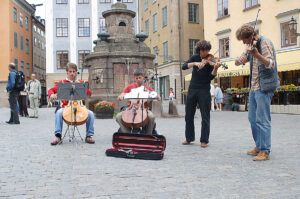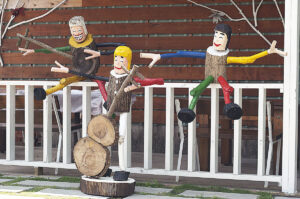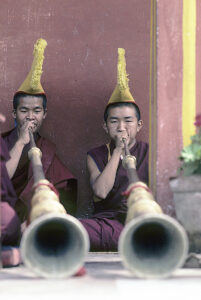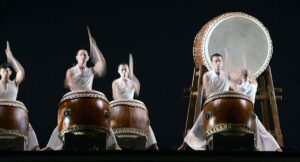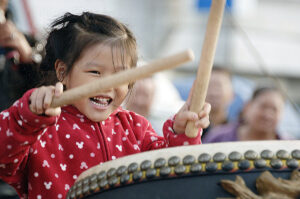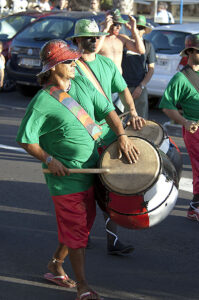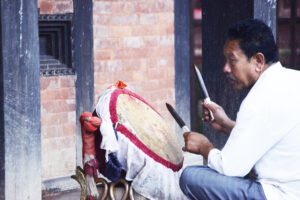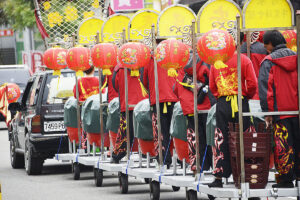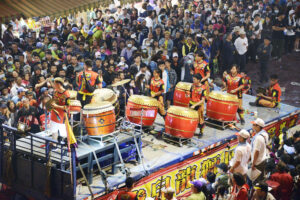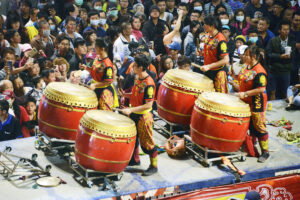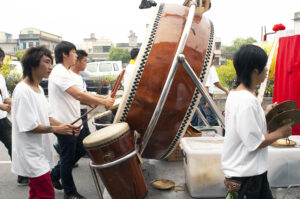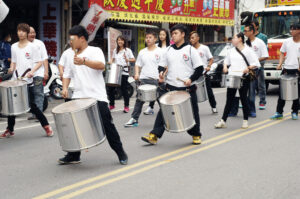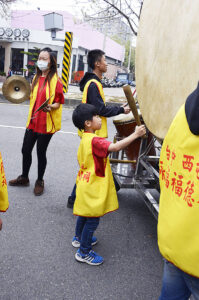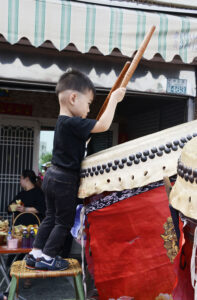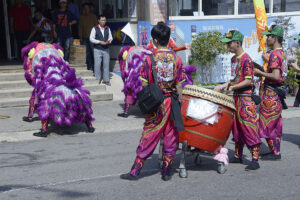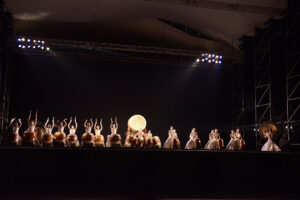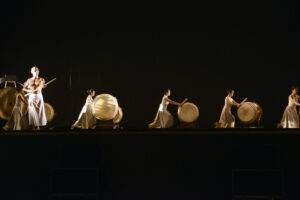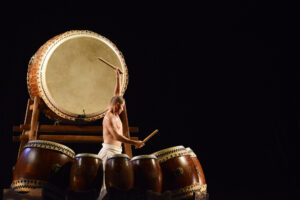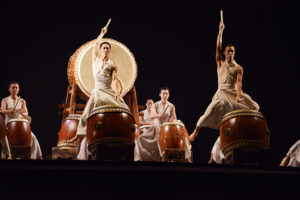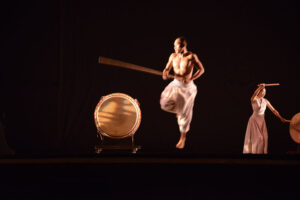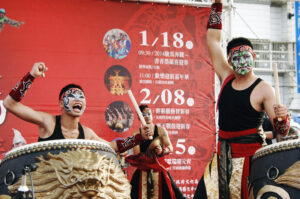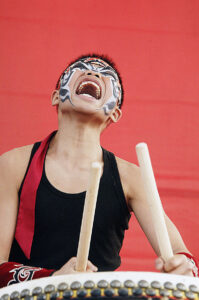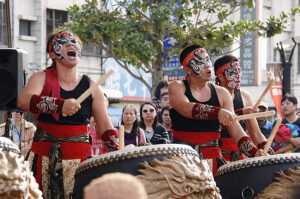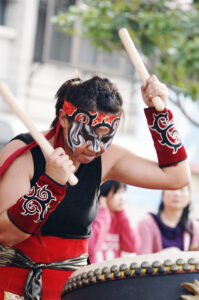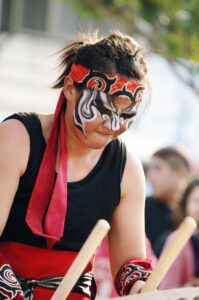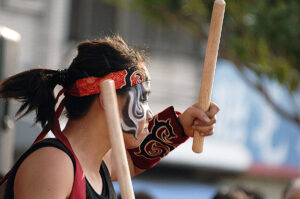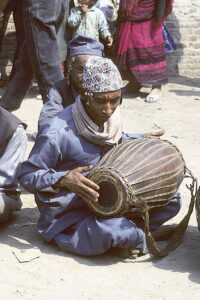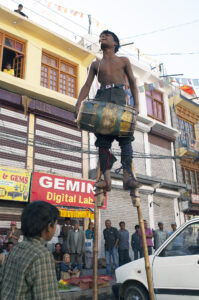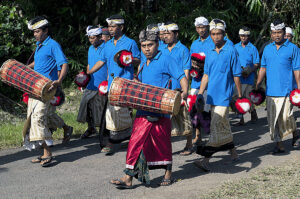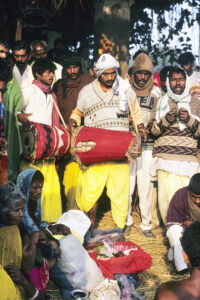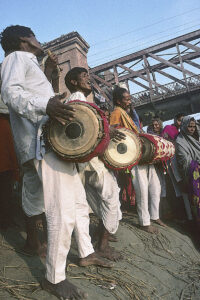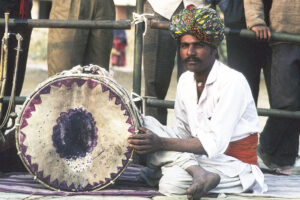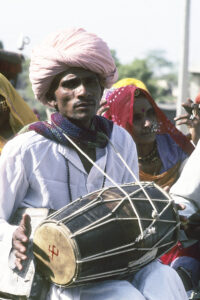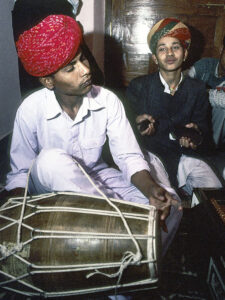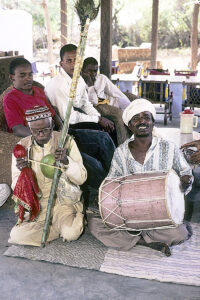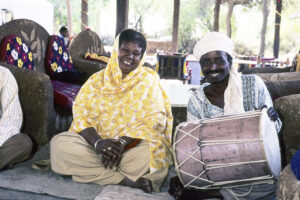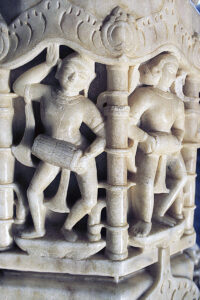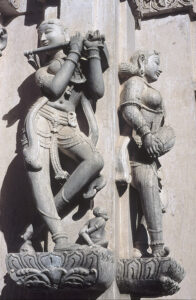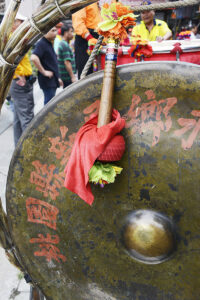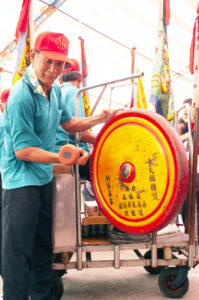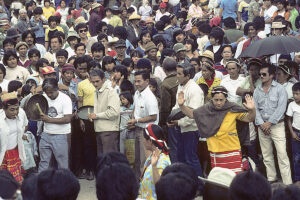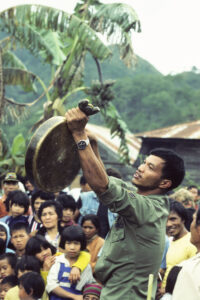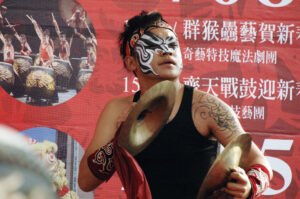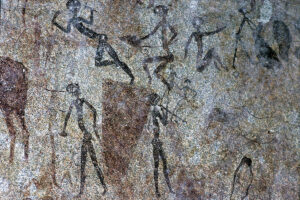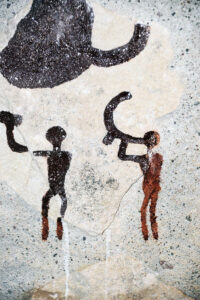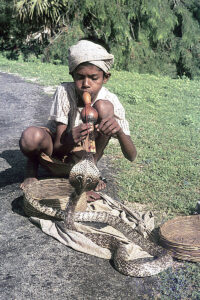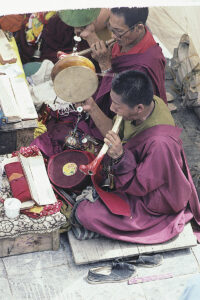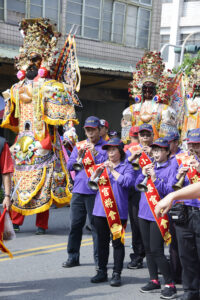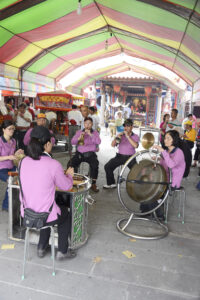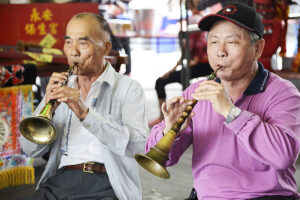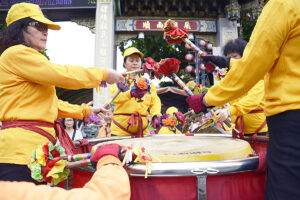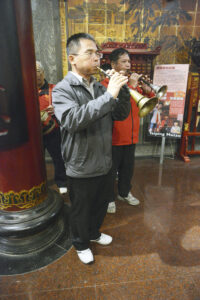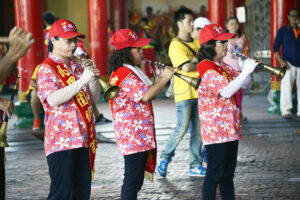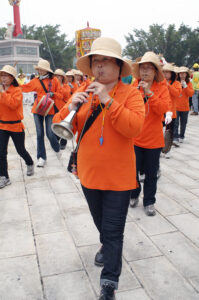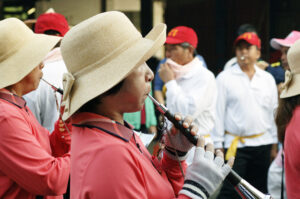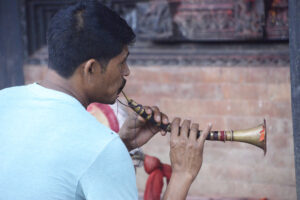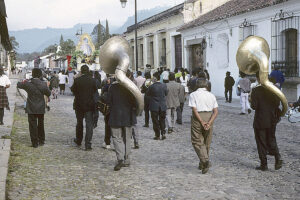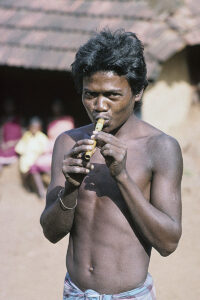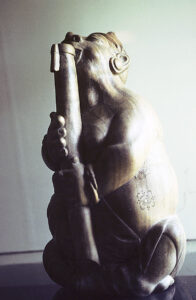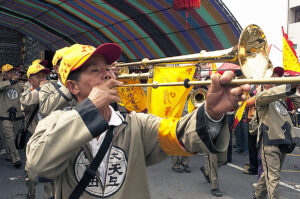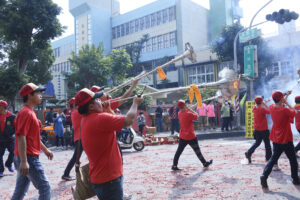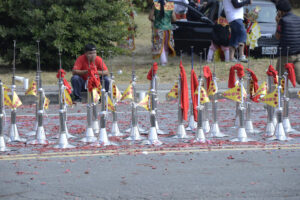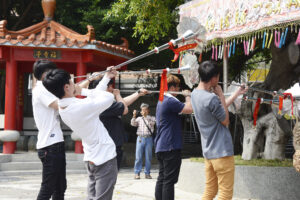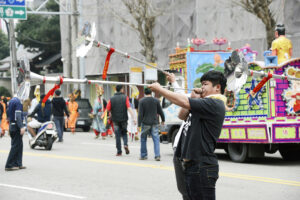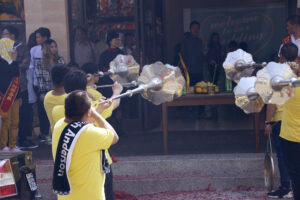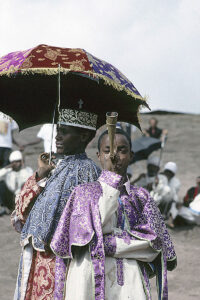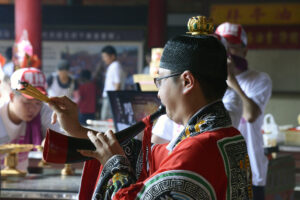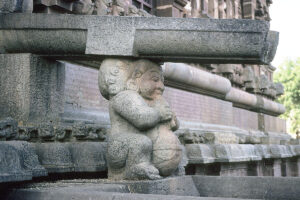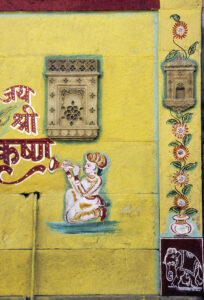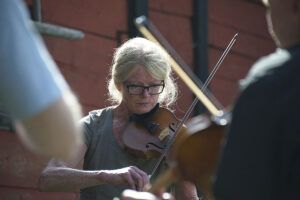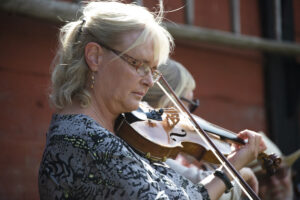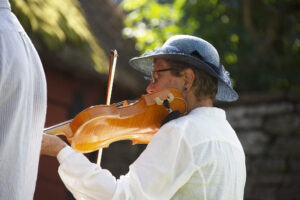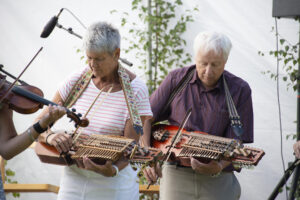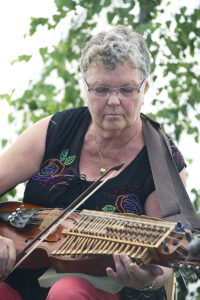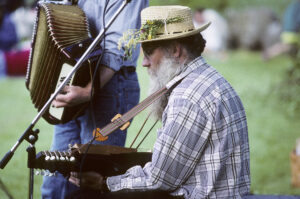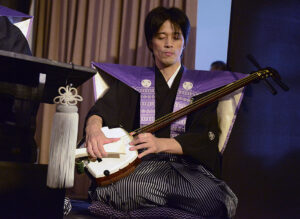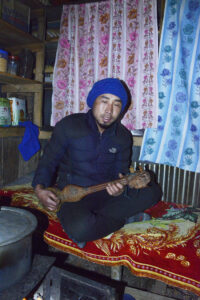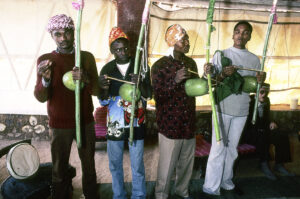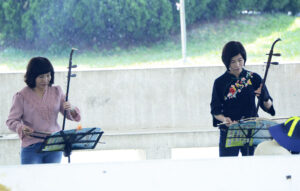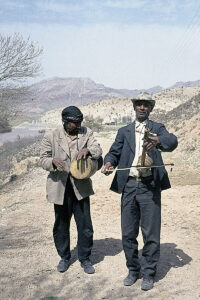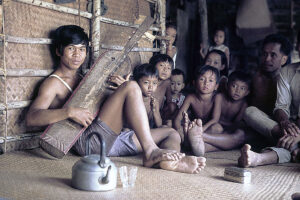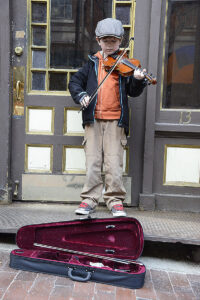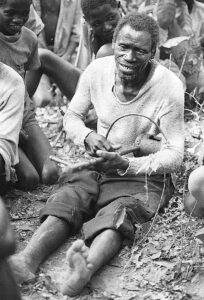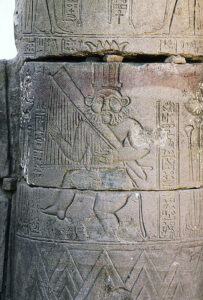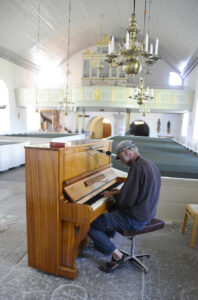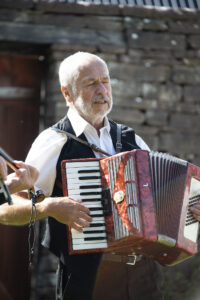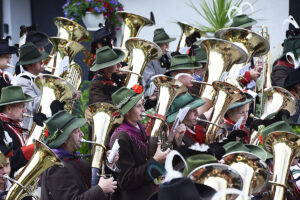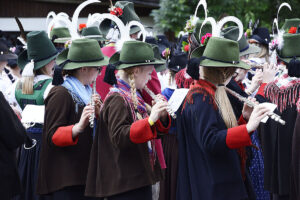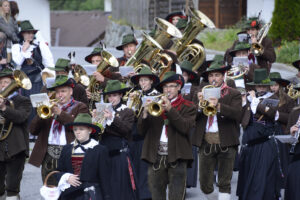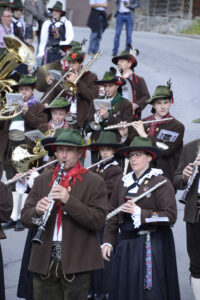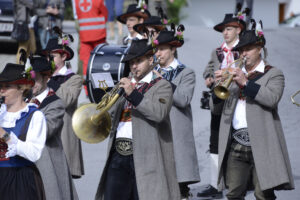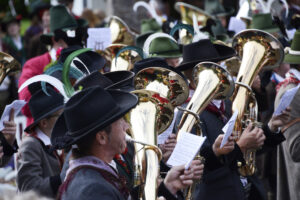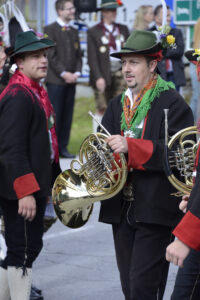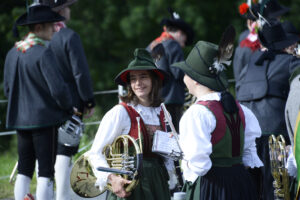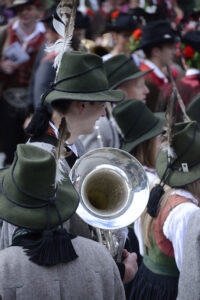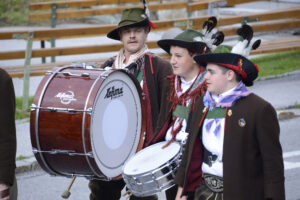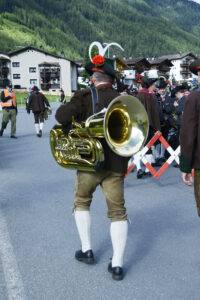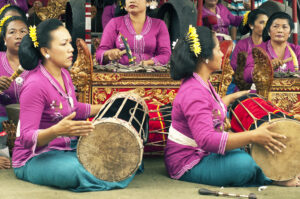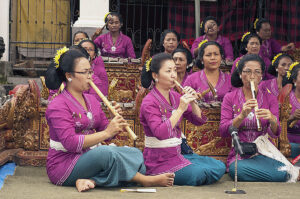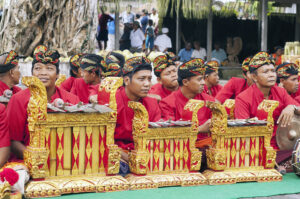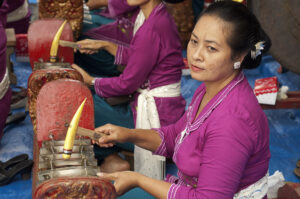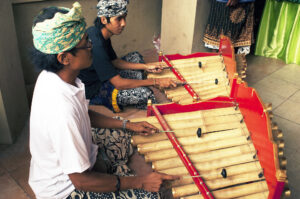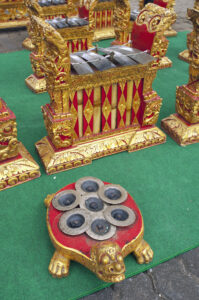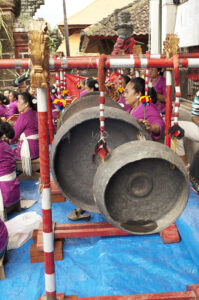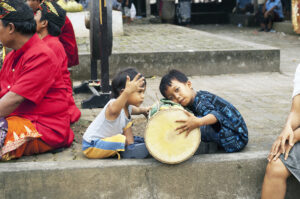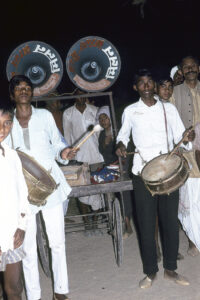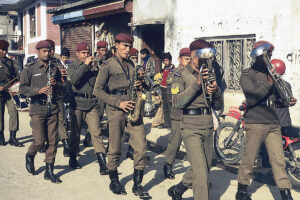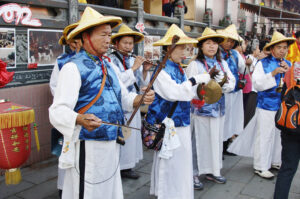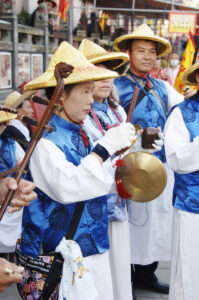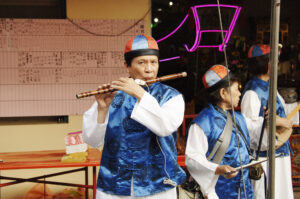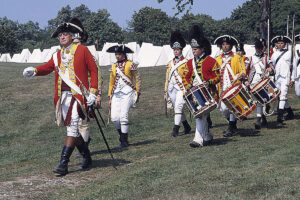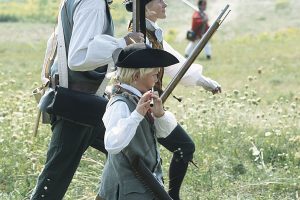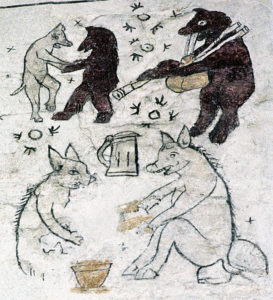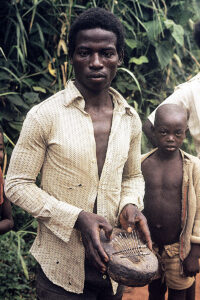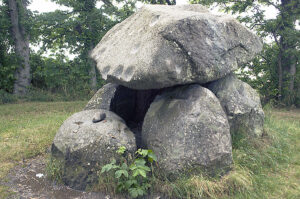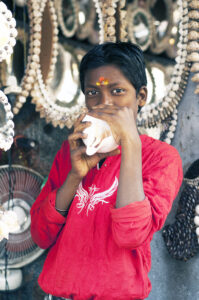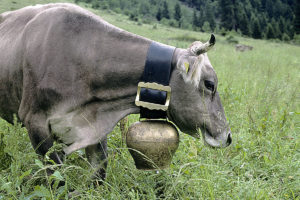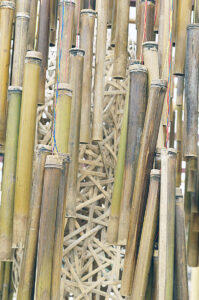Musicians
Musicians, playing classical music on a city square in Stockholm, Sweden. (Photo copyright © by Kaj Halberg)
These musicians, made from joined pieces of wood, were exhibited near the town of Shenghsing, Taiwan. – Other pictures, depicting similar handicrafts, are shown on the page Culture: Folk art of Taiwan. (Photo copyright © by Kaj Halberg)
Monks, blowing huge horns during a Buddhist initiation ceremony, taking place outside a Tibetan monastery next to the Bodhnath Stupa, Kathmandu, Nepal. – This stupa is presented in depth on the page Religion: Buddhism. (Photo copyright © by Kaj Halberg)
This theatre group in Taichung, Taiwan, named U-Theatre, perform the Sword of Wisdom – combined drumming and dancing with sticks. (Photo copyright © by Kaj Halberg)
I look at you all, see the love there that’s sleeping,
While my guitar gently weeps.
I look at the floor, and I see it needs sweeping.
Still, my guitar gently weeps.
I don’t know why nobody told you
How to unfold your love.
I don’t know how someone controlled you,
They bought and sold you.
I look at the world, and I notice it’s turning,
While my guitar gently weeps.
With every mistake, we must surely be learning.
Still, my guitar gently weeps.
First part of the song While My Guitar Gently Weeps (1968), written by George Harrison (1943-2001), lead guitarist in the rock band The Beatles. The song was written after the members of the band had been studying transcendental meditation in India in early 1968. It conveys Harrison’s dismay at the world’s wasted potential for universal love, referred to as “the love there that’s sleeping”.
Driving in my car,
Smoking my cigar,
The only time I’m happy’s when I play my guitar.
First verse of the song N.S.U. (1966), written by Scottish musician John Symon Asher Bruce (1943-2014), known as Jack Bruce, bass player and singer in the rock group Cream.
The N.S.U. was a small British sedan car, and the lyrics are about driving around and being carefree, but maybe wishing you had more.
Other members of Cream were guitarist Eric Patrick Clapton (born 1945) and drummer Peter Edward Baker (1939-2019), known as ‘Ginger’ Baker due to his flaming red hair.
Drums
One of the earliest instruments was the drum – originally probably a hollow tree trunk, beaten with a stick. Drumming is of great attraction to almost everybody, appealing to our deepest instincts. A selection of photographs below shows various types of drumming.
Drumming appeals to our deepest instincts. This Taiwanese child clearly enjoys playing on a drum. (Photo copyright © by Kaj Halberg)
Drummers, participating in a street carnival, Los Christianos, Tenerife, Canary Islands. (Photo copyright © by Kaj Halberg)
During a Hindu festival, celebrated at the Manakamana Kali Temple, central Nepal, this man is playing on a drum, using peculiar pointed drumsticks. (Photo copyright © by Kaj Halberg)
Drumming is a very important part of any Daoist event in Taiwan – temple festivals, parades, theatre performances, even funerals.
Daoism is dealt with in detail on the page Religion: Daoism in Taiwan.
During a Daoist parade in the city of Taichung, celebrating Chinese New Year, this long line of drums is pulled by a car. (Photo copyright © by Kaj Halberg)
Drummers parade during a festival in the town of Shingang, dedicated to the Daoist Mother Goddess Mazu. (Photos copyright © by Kaj Halberg)
These drummers participate in a procession during a festival in the town of Pitou, dedicated to Mazu. (Photo copyright © by Kaj Halberg)
Musicians perform with metal drums during the Daoist Lantern Festival, celebrated in the city of Taitung, eastern Taiwan. (Photo copyright © by Kaj Halberg)
Small boys, large drums. – Daoist parades in Taichung (top) and Shingang. (Photos copyright © by Kaj Halberg)
A Daoist lion dance, accompanied by drums, is performed in front of a shop in Taichung. Such ceremonies supposedly bring good luck to your business. (Photo copyright © by Kaj Halberg)
Brilliant drumming, performed by the group U-Theatre, Taichung, Taiwan. (Photos copyright © by Kaj Halberg)
During a performance in Taichung, the faces of these members of the Chio-Tian Folk Drums & Arts Troupe are painted to depict Bajiajiang – beneficial creatures, resembling devils. (Photos copyright © by Kaj Halberg)
A simple type of drum is the tabla, which is beaten with the fingertips.
This Newar-man is beating a tabla during the Hindu festival of Bisket Jatra, celebrated in the city of Bhaktapur, Kathmandu Valley, Nepal. The tika mark on his forehead, consisting of a mixture of mustard oil and red powder, also contains rice kernels, indicating that an important festival is taking place. His hat, called a topi, is typical of the Newar people. (Photo copyright © by Kaj Halberg)
Street performer, walking on stilts while playing on a tabla, Leh, Ladakh, India. (Photo copyright © by Kaj Halberg)
Musicians, playing on tablas and cymbals (see below), participate in a procession, bringing offerings to a Hindu temple near Ubud, Bali, Indonesia. (Photo copyright © by Kaj Halberg)
These men play tablas at a Hindu ceremony, taking place during the annual Sonpur Fair in Bihar, northern India. (Photos copyright © by Kaj Halberg)
During a camel festival, taking place in the city of Bikaner, Rajasthan, India, these musicians are performing with tablas. (Photos copyright © by Kaj Halberg)
Muslim musician, performing on a tabla, Udaipur, Rajasthan, India. (Photo copyright © by Kaj Halberg)
Sidis are an ethnic minority group in India and Pakistan, who descended from Bantu peoples of south-eastern Africa. Some arrived in Asia as merchants, sailors, or mercenaries, others were brought as servants or slaves. Today, the Sidi population is estimated at about 300,000 individuals, living mainly in Karnataka, Gujarat, and Hyderabad in India, and Makran and Karachi in Pakistan. A majority are Muslims, others are Hindus or Catholics.
During a performance at Zainabad, Gujarat, western India, Sidis are playing on tablas and a string instrument, called malunga. (Photos copyright © by Kaj Halberg)
Tabla player, Bwamba Forest, Uganda. (Photo copyright © by Kaj Halberg)
Musician with a huge tabla, participating in the Orthodox Christian festival Timkat, celebrated in the town of Lalibela, Ethiopia. This festival is described in detail on the page Travel episodes – Ethiopia 1996: Timkat – a Christian festival. (Photo copyright © by Kaj Halberg)
Drummer and tabla player, Kota Bharu, Malaysia. (Photo copyright © by Kaj Halberg)
Jain temples in western India are renowned due to their exquisite carvings in white marble. Other pictures from some of these marvellous temples are presented on the page Religion: Jainism.
Tabla players, carved into a marble column in the Vimal Vasahi Jain Temple at Dilwara, Mount Abu, Rajasthan. (Photo copyright © by Kaj Halberg)
This carving, depicting a female tabla player and a female flutist, adorns the Jain temple atop the Shetrunjaya Hill, near Palitana, Gujarat. (Photo copyright © by Kaj Halberg)
Yet another very simple type of ‘drum’ is the gong, a flat, circular metal disc, beaten with a mallet. This instrument is typical of China, Taiwan, Japan, Indochina, the Philippines, and Indonesia.
A member of the group U-Theatre beats a large gong, Taichung, Taiwan. (Photo copyright © by Kaj Halberg)
Gongs are a very common feature during Daoist festivals in Taiwan. This large one is displayed in the Longde Temple (‘Dragon Virtue’), Fenyuan, western Taiwan. (Photo copyright © by Kaj Halberg)
This man is beating a gong during a festival for the Daoist Mother Goddess Mazu, taking place in the town of Shingang, western Taiwan. (Photo copyright © by Kaj Halberg)
During a wedding celebration in the village of Sagada, northern Luzon, Philippines, Bontoc tribal women perform a dance, while men are beating gongs. (Photos copyright © by Kaj Halberg)
Batak tribals in the village of Tomok, Samosir Island, Sumatra, Indonesia, perform with gongs, drums, and a clarinet-like instrument. (Photo copyright © by Kaj Halberg)
A cymbal is a small, gong-like instrument, consisting of a curved metal plate. Two cymbals are often played simultaneously by beating them against each other.
During a performance in Taichung, Taiwan, this member of the Chio-Tian Folk Drums & Arts Troupe is playing on cymbals. His face is painted to depict a Bajiajiang – a beneficial creature, resembling a devil. (Photo copyright © by Kaj Halberg)
Wind instruments
Blowing through various tubes to produce sounds is another very early type of music. These tubes have evolved into a bewildering array of blowing instruments: flutes, lurs, horns, clarinets, and saxophones, to name but a few.
These cave paintings in McIlwaine Game Park, Zimbabwe, which were made by San people (‘Bushmen’), depict dancing people and a flute player. (Photo copyright © by Kaj Halberg)
This Bronze Age petroglyph, found on a stone slab in Kivik Royal Tomb, Skåne, Sweden, depicts people, blowing on lurs. – Other pictures, depicting Bronze Age petroglyphs, may be seen on the page Culture: Folk art around the world. (Photo copyright © by Kaj Halberg)
This boy in Polonnaruwa, Sri Lanka, makes a living as a snake charmer, playing on his flute to make a cobra (Naja naja) ‘dance’ in time with the music. (Photo copyright © by Kaj Halberg)
Celebrating the Buddha’s birthday at the Bodhnath Stupa, Kathmandu, Nepal, these monks play on flutes, made from human femurs. – This stupa is presented in depth on the page Religion: Buddhism. (Photo copyright © by Kaj Halberg)
During almost all Daoist festivals in Taiwan, a clarinet-like instrument is a very common feature. A number of pictures below show this instrument.
People play on the clarinet-like instrument during the festival Tzuoh Jiaw, celebrated in the village of Dalinpo, near Kaohshiung. The huge puppets in the upper picture depict various Daoist mythological heroes. (Photos copyright © by Kaj Halberg)
Celebrating the Daoist god of medicine, Bao Shang, men in the Longde Temple (‘Dragon Virtue’), Fenyuan, western Taiwan, play on the clarinet-like instrument, while women play on cymbals, a gong, and a huge drum. (Photos copyright © by Kaj Halberg)
Celebrating the Chinese New Year 2015 in the Fushing Temple, Xiluo, these men are playing on the clarinet-like instrument. (Photo copyright © by Kaj Halberg)
During a festival in the town of Beimen, western Taiwan, celebrating the Daoist god of diseases, Wang-yeh, these women play on the clarinet-like instrument. (Photo copyright © by Kaj Halberg)
During the Boat Burning Festival, likewise honouring Wang-yeh, women play on the clarinet-like instrument at the Samlong Temple on Siao Liouchou Island. (Photos copyright © by Kaj Halberg)
During a Hindu festival, celebrated at the Manakamana Kali Temple, Nepal, this man is blowing on a local wind instrument. (Photo copyright © by Kaj Halberg)
Men, blowing huge, winding horns during a catholic procession in the city of Antigua, Guatemala, honouring Santa Clara of Assisi (1194-1253), one of the first followers of St. Francis. (Photo copyright © by Kaj Halberg)
Mali tribal, playing a flute, Odisha (Orissa), India. – Other pictures, depicting Indian tribals, are shown on the page People: Vanishing peoples of India. (Photo copyright © by Kaj Halberg)
This Balinese wood carving depicts a man, playing on a bamboo flute. (Photo copyright © by Kaj Halberg)
Celebrating the Hindu festival Dassera, or Durga Puja, men in the city of Kullu, Himachal Pradesh, India, blow on huge, lur-like brass horns. – More about Hindu festivals is found on the page Travel episodes – India 1991: Attending Hindu festivals in Rajasthan. (Photos copyright © by Kaj Halberg)
During a festival, dedicated to the Daoist Mother Goddess Mazu, celebrated in the town of Pitou, Taiwan, these people blow on long, lur-like brass horns. (Photos copyright © by Kaj Halberg)
These men, blowing on silvery, lur-like instruments, participate in a procession, taking place during the Daoist festival Tzuoh Jiaw, celebrated in the village of Dalinpo, near Kaohshiung, Taiwan. During this festival, local gods are worshipped to prevent bad events in the future. (Photos copyright © by Kaj Halberg)
Lur-like instruments, lined up during the Tzuoh Jiaw festival, Dalinpo. (Photo copyright © by Kaj Halberg)
Men, blowing on lur-like instruments during a procession in the city of Taichung, Taiwan. In the upper picture, they perform in front of a temple, in the lower two in front of shops, which supposedly brings prosperity to the owners. (Photos copyright © by Kaj Halberg)
This priest is blowing a horn during the Orthodox Christian festival Timkat, celebrated in the town of Lalibela, Ethiopia. This festival is described in detail on the page Travel episodes – Ethiopia 1996: Timkat – a Christian festival. (Photo copyright © by Kaj Halberg)
During a festival in the town of Beimen, western Taiwan, celebrating the Daoist god of diseases, Wang-yeh, this monk is blowing on an instrument, made from a cow’s horn. (Photo copyright © by Kaj Halberg)
This sculpture, encountered in the Hindu temple Brihadisvara, Thanjavur, Tamil Nadu, South India, depicts a being, blowing into a bag-pipe. It is quite similar to the European gargoyle, acting as support for a drainage pipe for rain water. – Gargoyles are described on the page Nature: Rain and dew. (Photo copyright © by Kaj Halberg)
This wall painting on a house in Jaisalmer, Rajasthan, India, depicts a musician, blowing on a clarinet-like instrument. (Photo copyright © by Kaj Halberg)
String instruments
A third type of instrument is the string instrument, in which you strike your finger nail, or another hard object, on strings, amplifying the produced sound in a gourd, or some other hollow object. Or you may rub a bow, made from cat’s hair or the like, on the strings to produce sounds.
In the old days, the strings were made of dried intestines, later of steel. Today, plastic strings are widely used.
Violinists, performing at the Himmelsberga Museum, Öland, Sweden. (Photos copyright © by Kaj Halberg)
Likewise at the Himmelsberga Museum, these people are playing on an old hurdy-gurdy-like Swedish instrument, called nyckelharpa. (Photos copyright © by Kaj Halberg)
During the Midsummer’s Festival, celebrated at Himmelsberga, musicians play on nyckelharpa and accordion. (Photo copyright © by Kaj Halberg)
Kabuki performance (Japanese theatre) in the city of Huwei, Taiwan. The musician is playing on a shamisen, or sangen (both words mean ‘three strings’), a traditional Japanese string instrument, on which you use a broad plectrum, called bachi. (Photo copyright © by Kaj Halberg)
Young man, playing on a tungna, a Himalayan string instrument, Gopte, Langtang National Park, Nepal. (Photo copyright © by Kaj Halberg)
A blind Shona musician and his assistant perform on the street in Harare, Zimbabwe. While playing a guitar, the man is moving a puppet with his toes, making it ‘dance’ in time with the music. (Photo copyright © by Kaj Halberg)
During a performance at Zainabad, Gujarat, western India, Sidis are playing on a string instrument, called malunga. The Sidis are described above under drums. (Photo copyright © by Kaj Halberg)
Street musician, playing on a local string instrument, Pushkar, Rajasthan, India. (Photo copyright © by Kaj Halberg)
In a city park in Taichung, Taiwan, these women spend the morning, playing on a two-stringed instrument, called erhu. (Photo copyright © by Kaj Halberg)
Wandering minstrels in Luristan, Iran, playing on a local string instrument and a tabla. I explored this area together with my late friend Arne Koch Christoffersen, see page Travel episodes – Iran 1973: In the mountains of Luristan. (Photo Arne Koch Christoffersen, copyright © by Kaj Halberg)
This Iban tribal, who lives in a village near the Kakus River, Sarawak, Borneo, is playing on a traditional string instrument, named sapé. (Photo copyright © by Kaj Halberg)
Young street performer, playing a violin, Old Portland, Maine, United States. (Photo copyright © by Kaj Halberg)
A wandering musician and his son (?) enjoy a break outside the Mehrangarh Fort, Jodhpur, Rajasthan, India. The musician has only one leg – the artificial one is seen to the right. (Photo copyright © by Kaj Halberg)
Wandering minstrel, playing on a local string instrument, Litipo Forest, southern Tanzania. (Photo copyright © by Kaj Halberg)
During a camel festival in the city of Bikaner, Rajasthan, India, this man is playing on a local string instrument. (Photo copyright © by Kaj Halberg)
The harp is an advanced type of string instrument, on which you use the fingers of both hands to produce sounds.
In Ancient Egypt, the god Bes was defending the good and fighting the evil. This relief in the temple of Hathor, Philae, Aswan, depicts this deity, playing on a harp. (Photo copyright © by Kaj Halberg)
Piano and accordion
The piano was invented by Italian Bartolomeo Cristofori di Francesco (1655-1731) around the year 1700. It is a keyboard instrument with strings inside, which, when pressing the keys down with the fingers, are struck by wooden hammers, coated with wool felt.
An accordion is a box-shaped musical instrument, played by compressing or expanding bellows with your left hand, while pressing buttons or keys with your right hand. The pressing causes pallets to open, allowing air to flow across strips of brass or steel, called reeds, which vibrate to produce sounds inside the body.
On the island of Öland, Sweden, Lars Skipper and I paid a visit to Föra Church. Inside was a small piano, and Lars couldn’t resist playing on it. (Photo copyright © by Kaj Halberg)
Moving a piano into a farm house, Denmark. (Photo copyright © by Kaj Halberg)
This man is playing on an accordion, performing at the Himmelsberga Museum, Öland, Sweden. (Photo copyright © by Kaj Halberg)
Orchestras
During an annual music festival, orchestras from various local communities in Tirol, Austria, gather in a village, in this case Prägraten, Virgen Valley. Most members are clad in traditional dress. The white feathers in some of the hats are so-called ‘chamois feathers’, symbolizing a tuft of hairs from the back of the chamois (Rupicapra rupicapra). In former days, Austrian hunters would often attach such tufts to their Tyrolian hat.
(Photos copyright © by Kaj Halberg)
In the pictures below, various music instruments are played during a Hindu temple festival in Ubud, Bali, Indonesia, including flutes, xylophones, gongs, and tablas.
(Photos copyright © by Kaj Halberg)
Musicians, entertaining during a pre-wedding celebration in the village of Sunderpur, between Dausa and Sawai Madhopur, Rajasthan, India. (Photos copyright © by Kaj Halberg)
Army musicians perform during a wedding procession in Kathmandu, Nepal. (Photo copyright © by Kaj Halberg)
During the Daoist Boat Burning Festival, here taking place in the village of Jiading, near Kaoshiung, Taiwan, musicians march in front of the boat, which is later burned as an offering to the god of diseases, Wang-yeh. This festival, and many other Daoist festivals, are described on the page Religion: Daoism in Taiwan. (Photo copyright © by Kaj Halberg)
Musicians perform during the Boat Burning Festival, celebrated on Siao Liouchou Island, playing on a two-stringed instrument, called erhu, flutes, gongs, and a clarinet-like instrument. (Photos copyright © by Kaj Halberg)
In September 2001, my late friend John Burke and I attended an outdoor play at Fort Ticonderoga, Lake Champlain, New York State, in which scenes from the American Revolutionary War (1763-1783) were re-enacted, including orchestras. Several pictures from this performance are shown on the page Novel: Rose of the Revolution.
In this picture, volunteers perform as English troops, marching into battle. (Photo copyright © by Kaj Halberg)
A young flutist, marching with revolutionary troops. (Photo copyright © by Kaj Halberg)
Miscellaneous
This mural in Povls Church, Bornholm, Denmark, depicts serious sins, such as playing music, dancing, and playing games – at least according to certain puritanical Christian sects. (Photo copyright © by Kaj Halberg)
A widespread African musical instrument is the mbira, or kalimba – in English called a thumb piano. This instrument consists of a wooden board, fitted with a resonator, e.g. a small gourd. On the board, metal tines of uneven length are attached, and you play by holding the instrument in both hands, plucking at the tines with your thumbs.
This man in Zaire is playing on a mbira. (Photo copyright © by Kaj Halberg)
Klokkestenen (‘The Bell Stone’) is a dolmen from the Stone Age (c. 3000 B.C.), situated on the island of Lyø, Denmark. The small depressions in the stone are made over time by thousands of people, hitting the stone with a small rock, hereby producing a bell-like sound.
Numerous types of megalithic structures are presented on the page Culture: Megaliths.
(Photo copyright © by Kaj Halberg)
This Hindu boy works in a shop in Haridwar, Uttarakhand, India, selling seashells and conches. He demonstrates how to blow in a conch. (Photo copyright © by Kaj Halberg)
Almost all cows, grazing on mountain meadows in the Alps, wear bells, creating music when they move around on the meadows, like this one near Säntis, Sankt Gallen, Switzerland. (Photo copyright © by Kaj Halberg)
Wind-charms are made from bamboo stems of unequal length, which are hung up in strings. When the wind blows, the stems bang against one another, creating nice sounds. This one was seen in Lugu, Taiwan. (Photo copyright © by Kaj Halberg)
(Uploaded September 2017)
(Latest update March 2024)
